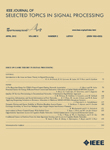
IEEE Journal of Selected Topics in Signal Processing
Scope & Guideline
Unlocking the Potential of Electrical Engineering Innovations
Introduction
Aims and Scopes
- Signal Processing for Intelligent Systems:
The journal highlights advancements in signal processing methods that enhance the capabilities of intelligent systems, particularly in robotics, autonomous vehicles, and smart environments. - Machine Learning and AI Integration:
A consistent focus on integrating machine learning and artificial intelligence techniques with signal processing to improve performance in areas such as image recognition, speech processing, and sensor data analysis. - Wireless Communications and Networking:
Research that explores signal processing innovations for enhancing communication systems, particularly in the context of emerging technologies such as 5G and beyond, including aspects like resource allocation and interference management. - Multimodal Data Fusion:
The journal emphasizes methodologies for fusing data from various modalities (e.g., audio-visual, radar-camera) to improve recognition and tracking tasks, crucial for applications in surveillance and human-computer interaction. - Digital Twin Technology:
An emerging area of focus that examines the role of signal processing in the development and optimization of digital twins across various industries, enhancing predictive maintenance and system performance.
Trending and Emerging
- Robustness in AI Models:
Recent publications emphasize the development of robust AI models capable of functioning effectively in uncertain or complex environments, particularly for applications in robotics and autonomous systems. - Digital Twin and IoT Integration:
There is a growing trend towards exploring the role of signal processing in digital twin technologies and their integration with the Internet of Things (IoT), enhancing real-time data analysis and system optimization. - Advanced Machine Learning Techniques:
An increase in research focusing on advanced machine learning methods, including reinforcement learning and generative models, showcases the journal's alignment with cutting-edge computational approaches. - Semantic Communications:
Emerging themes in semantic communications highlight the importance of context and meaning in data transmission, reflecting a shift towards more efficient and intelligent communication systems. - Multimodal and Cross-Modal Learning:
The journal is increasingly publishing research on multimodal learning techniques, which combine data from different sources (e.g., visual and auditory) to improve system performance in recognition and interaction tasks.
Declining or Waning
- Traditional Signal Processing Techniques:
There has been a noticeable decline in papers focusing on classical signal processing techniques, such as basic filtering or Fourier analysis, as researchers increasingly lean towards advanced machine learning methods. - Basic Audio Processing:
Research centered on conventional audio signal processing methods has decreased, likely due to the shift towards more complex and integrated approaches that incorporate machine learning for enhanced audio recognition and enhancement. - Low-Level Image Processing:
Papers that deal with fundamental image processing techniques, such as basic edge detection and histogram equalization, are less common, as the field moves towards more sophisticated deep learning frameworks. - Conventional Data Compression Methods:
There is a waning interest in traditional data compression algorithms, as newer methods leveraging neural networks and deep learning have gained prominence, showcasing superior performance in real-world applications.
Similar Journals

Journal of Signal Processing Systems for Signal Image and Video Technology
Transforming Theoretical Insights into Practical Applications.Journal of Signal Processing Systems for Signal Image and Video Technology, published by SPRINGER, is a leading interdisciplinary journal dedicated to advancing research and development in the fields of signal processing, image processing, and video technology. With an ISSN of 1939-8018 and an E-ISSN of 1939-8115, this journal emphasizes both theoretical and practical applications, boasting a wide scope that ranges from control and systems engineering to hardware architecture. Since its inception in 2008, it has gained a solid reputation, reflected in its 2023 category quartile rankings—including Q2 in Control and Systems Engineering and Q3 in Signal Processing—demonstrating its significance within the academic community. The journal is underpinned by a commitment to open access, promoting broad dissemination of knowledge, and is particularly vital for researchers, professionals, and students looking to contribute to and stay updated in these rapidly evolving fields. With ongoing explorations into the convergence of technology and methodology until 2024, the journal stands as a crucial resource for the latest innovations and discussions in signal processing systems.
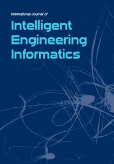
International Journal of Intelligent Engineering Informatics
Transforming Ideas into Intelligent Solutions.International Journal of Intelligent Engineering Informatics, published by INDERSCIENCE ENTERPRISES LTD, stands at the forefront of research in the interdisciplinary domains of computer science, artificial intelligence, and human-computer interaction. With an ISSN of 1758-8715 and E-ISSN of 1758-8723, this journal serves as a vital resource for researchers and professionals seeking to explore the latest advancements in intelligent engineering and informatics techniques crucial for the evolution of modern technologies. Although currently not an open-access publication, it provides a necessary platform for disseminating high-quality research; its impact factor continues to grow, attracting a diverse readership interested in signal processing, software development, and computer vision. Covering innovative topics from 2022 to 2024, the journal is committed to fostering scholarly dialogue that paves the way for emerging trends and applications in the field, ensuring its relevance and significance in today's rapidly advancing technological landscape.
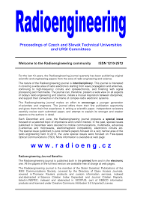
Radioengineering
Advancing the frontiers of radioengineering research.Radioengineering is a prominent academic journal published by SPOLECNOST PRO RADIOELEKTRONICKE INZENYRSTVI, focusing on the fields of electrical and electronic engineering. Established in 1992, this open access journal aims to disseminate high-quality research and innovative developments in radioengineering and related disciplines. With an inclusive readership from around the world, it has been integral in fostering advancements in technologies such as wireless communication, signal processing, and electromagnetic theory. The journal's commitment to accessibility is underscored by its open access policy, allowing scholars and practitioners to freely engage with the latest findings. As of 2023, *Radioengineering* holds a Q3 quartile ranking in its field with a Scopus rank of #500/797, placing it within the 37th percentile among its peers. Researchers, professionals, and students engaged in electrical and electronic engineering will find *Radioengineering* an essential resource for both theoretical insights and practical applications. For further information, submissions, and access to articles, please visit the journal’s site linked through the CZECH TECHNICAL UNIVERSITY, located in Prague, Czech Republic.

Electronics
Unveiling Insights in Electronics and CommunicationElectronics, published by MDPI since 2012, stands as a pivotal open-access journal that caters to a wide spectrum of disciplines within the electrical and electronic engineering domain. With a strong commitment to disseminating innovative research, this journal has garnered notable recognition, achieving a Q2 ranking in multiple pertinent categories, including Computer Networks and Communications, Control and Systems Engineering, and Signal Processing. Its editorial standards and open-access format enhance the visibility and accessibility of high-quality research, making critical advancements in technology available to a global audience. Located in Switzerland, the journal is positioned to foster international collaboration and dialogue among researchers, professionals, and students dedicated to exploring the evolving landscape of electronics and its applications. With an E-ISSN of 2079-9292, the journal is meticulously indexed in reputable databases like Scopus, further solidifying its relevance and influence in the engineering community.

IEEE Open Journal of the Communications Society
Unlocking Access to Pioneering Communication StudiesWelcome to the IEEE Open Journal of the Communications Society, a premier open-access publication dedicated to advancing the fields of computer networks and communications. Launched in 2020 by the esteemed IEEE-Institute of Electrical and Electronics Engineers, this journal operates under a commitment to disseminate high-quality, peer-reviewed research that fosters innovation and collaboration within the global communications community. With an impressive impact factor and currently positioned in the Q1 category of Time's rankings for Computer Networks and Communications (2023), the journal ranks 21st out of 395 in its field, placing it within the top 6% globally. It serves as a vital forum for researchers, professionals, and students, providing them with immediate access to pioneering studies and emerging trends. Being fully open access, all published articles are freely available to enhance the reach and impact of your research. Join us in exploring transformative ideas and technologies that shape the future of communications.

Jordan Journal of Electrical Engineering
Connecting Ideas, Inspiring Solutions in EngineeringJordan Journal of Electrical Engineering, published by TAFILA TECHNICAL UNIVERSITY (TTU) in Jordan, serves as a critical platform for disseminating groundbreaking research in the fields of electrical engineering, energy systems, and related disciplines. With an ISSN of 2409-9600 and an E-ISSN of 2409-9619, the journal is committed to promoting advancements in energy engineering, biomedical applications, control systems, and signal processing among others. Despite its recent establishment in 2023, it has been indexed in multiple categories within Scopus, receiving rankings that reflect its emerging role in the academic community. Researchers and professionals are encouraged to contribute and access cutting-edge articles through open access options, ensuring that knowledge is readily available to all interested parties. As the journal continues to grow, it aims to bridge gaps in knowledge and stimulate dialogue, thereby supporting innovation and practical applications in the engineering sector.

International Arab Journal of Information Technology
Pioneering Insights in the Realm of Information TechnologyWelcome to the International Arab Journal of Information Technology, a prestigious publication under the aegis of ZARKA PRIVATE UNIVERSITY in Jordan, dedicated to advancing the field of Information Technology. First established in 2008, this journal has made significant strides in disseminating high-quality research, achieving an impressive Q2 ranking in Computer Science (miscellaneous) and securing a notable 57th percentile position in the Scopus rankings. With a comprehensive scope encompassing various sub-disciplines of computer science, the journal is committed to promoting scholarly dialogue and innovation among researchers, professionals, and students. While currently operating as a subscription-only journal, it remains a vital resource for the academic community seeking to explore the latest trends and advancements in technology. The International Arab Journal of Information Technology is not only a platform for original research but also a vibrant hub for ideas that shape the technological landscape of the Arab region and beyond.
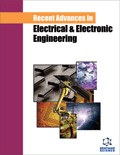
Recent Advances in Electrical & Electronic Engineering
Connecting Knowledge with Engineering SolutionsRecent Advances in Electrical & Electronic Engineering is a prominent scholarly journal dedicated to publishing cutting-edge research and developments in the fields of electrical and electronic engineering. Published by BENTHAM SCIENCE PUBL LTD, this journal aims to disseminate significant findings that advance knowledge and technology across various disciplines related to electrical and electronic engineering. With an ISSN of 2352-0965 and an E-ISSN of 2352-0973, the journal is accessible to a global audience, facilitating open scholarly discourse. Although it currently holds a Q4 ranking in both electrical and electronic engineering and materials science categories, it contributes to ongoing dialogues critical for advancing innovations within these sectors. Notably, the journal’s convergence years span from 2007 to 2024, securing its continual relevance in an evolving academic landscape. With a commitment to high-quality research, this journal serves as an essential resource for researchers, professionals, and students seeking to stay abreast of advancements and emerging challenges within the realm of electrical and electronic engineering.

EURASIP Journal on Advances in Signal Processing
Unveiling Breakthroughs in Hardware and Architecture Applications.EURASIP Journal on Advances in Signal Processing, published by Springer, is a premier open-access journal that has been at the forefront of research in the field of signal processing since its inception in 2001. With a focus on advancing the disciplines of Electrical Engineering, Hardware and Architecture, and Signal Processing, this journal plays a crucial role in disseminating innovative findings and facilitating collaboration among academics and industry professionals. Ranking in Q2 for Electrical and Electronic Engineering and Q3 in both Hardware and Architecture and Signal Processing as per the 2023 category quartiles, it highlights the journal's commitment to high-quality research. The journal is indexed in Scopus, reflecting its reputable standing within the global research community. Researchers, professionals, and students are invited to contribute to and benefit from the wealth of knowledge and advancements presented in each issue, furthering their understanding and application of state-of-the-art signal processing techniques.
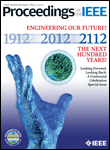
PROCEEDINGS OF THE IEEE
Showcasing Breakthroughs that Shape Tomorrow's TechnologiesPROCEEDINGS OF THE IEEE, published by the IEEE-Institute of Electrical and Electronics Engineers Inc, stands as a premier journal within the fields of Computer Science and Electrical and Electronic Engineering. Since its inception in 1963, it has provided a platform for cutting-edge research and developments, showcasing innovative studies and breakthrough technologies that influence academia and industry alike. With an impressive Q1 ranking in both fields according to the latest quartiles, this journal ranks among the top in its categories, holding a prestigious spot in the Scopus metrics—ranking 1st in General Computer Science and 4th in Electrical and Electronic Engineering. Researchers, professionals, and students benefit from its comprehensive scope that includes a wide range of topics from algorithms and computing systems to circuit design and network technologies. Additionally, though not available as an open-access publication, its significant impact factor signifies its role in advancing scholarly dialogue and innovation in these fast-evolving fields. With contributions from leading experts and a commitment to high-quality research, the PROCEEDINGS OF THE IEEE continues to be an essential resource for anyone invested in technological progress and scientific inquiry.